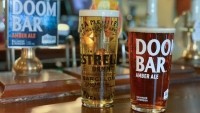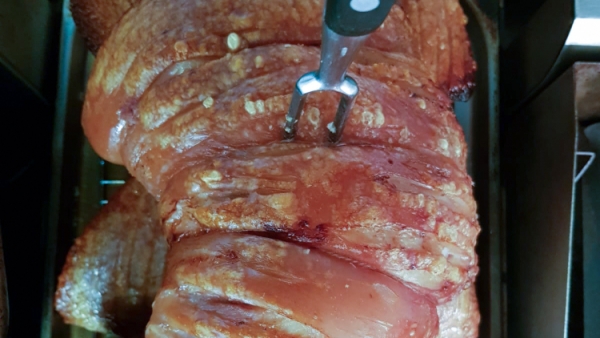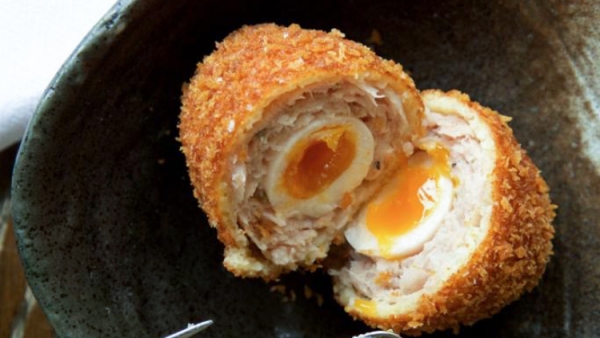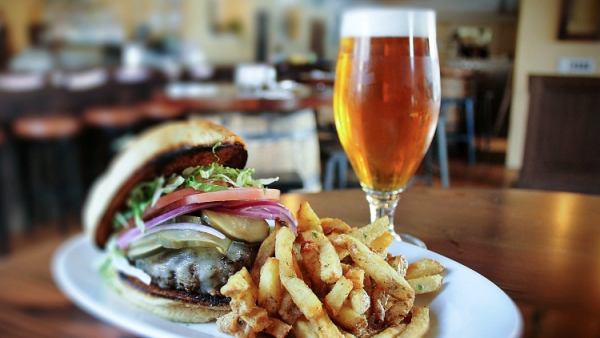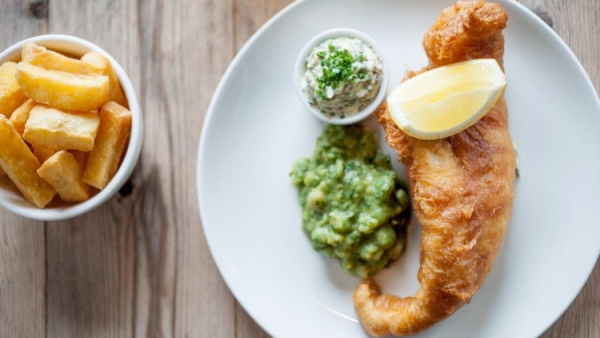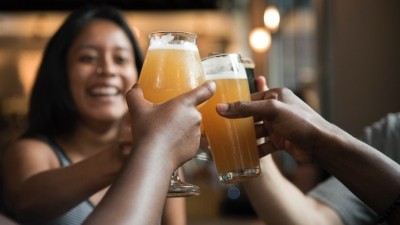Beer and food pairing: meet your match
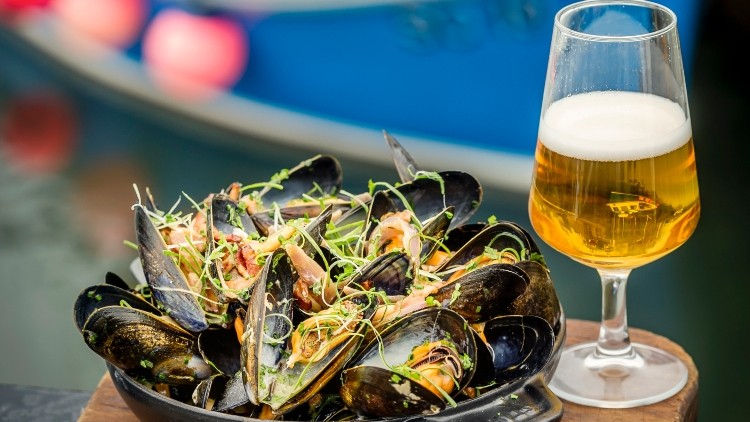
Pairing beer with food to bring out certain flavours in each is still a relatively new concept for most pubgoers, according to Ed Hughes beer sommelier at Sharp’s Brewery.
“We have done wine and food for so long, but ironically, beer is 9,000 years old,” Hughes says.
The brewery released a cookbook – Just Add Beer – in a bid to convince consumers of the flavour opportunities and combinations out there earlier this year.
The sharp end
Sharp’s Brewery says its flagship Offshore Pilsner is a perfect match with a spiced crab arancini or a crab taco. The drink’s full flavour and New World-influenced hops lift white crab meat without overpowering it. Its higher carbonation means the drink can be paired as a sparkling wine or Prosecco would be.
Sharp’s beer sommelier Ed Hughes recommends: “If you’re going for a food pairing, you can do those dishes or pop it into a Champagne flute and treat it like an aperitif.
“It’s how we have been conditioned as beer drinkers. The usual treatment for beer has always been to put it in a pint glass, but as soon as you put it in a Champagne flute, a balloon or a wine glass, you treat that liquid with a little bit more respect.
Be flexible on rules
When it comes to matching drinks with dishes, Hughes recommends pub teams start with a basic principle and experiment to find winning pairings that fit with the site’s individual identity.
He explains: “I tend not to go for hard and fast rules and [instead] start off with the absolute basics of lighter beers with lighter dishes and then richer beers with richer dishes.
“I know it seems really obvious but the majority of the tastings that I do, most people have never done beer and food.
“We want people to go on their journey [with the cookbook]. I realised the absolute majority of people are starting from scratch or know very little, they haven’t done it apart from lager and a curry or a pie and a pint.
“It’s to really give people those tools to have a guide to beer that’s widely available to go with a dish or a beer style, so it’s not being dictatorial about it. It’s hopefully giving people a bit of a toolbox.”
Menu ideas
Using menus to signpost to customers which combinations work well is a good starting point for both pub teams and drinkers who are new to the concept of matching, Hughes says.
He adds: “To start off with, upskilling the staff – front of house especially – is needed so training is vital. That’s industry-wide, whether it’s pub operators or restaurant operators.
“A handy thing to do is to speak to whoever the supplier is and when they’re writing a menu, get a beer specialist to offer a suggestion of a beer and food pairing or even a drink and food pairing.
“That’s the way to get customers involved because it can be seen as relatively novel. The more people are signposted to do so, the more likely they will end up doing it.”
Simply the language
Keeping language simple is also key in the eyes of Adam Dulye, executive chef for the Brewers Association, a not-for-profit trade association dedicated to small and independent American craft brewers.
“When thinking about your beer and food pairing strategy, a good approach is to go with flavour first and style second,” he advises.
“Beer lovers new to American craft beer may not know what an IPA is or what to expect from a porter.
“By using words everyone can relate to from bitter to citrus, pine to floral for IPA or chocolate and caramel for a porter, your customers will feel comfortable with the language being used and understand what they are ordering.”
Offer an exceptional ride
Communicating the reasons why a drink works well in tandem with a certain type of food is just as important as informing customers of what the winning combinations available are, Dulye notes.
His advice to pub staff is: “Make the event an experience as much as a tasting. Impart knowledge and explain the thinking behind each pairing. For example, a hot curry will pair well with a hop-forward IPA because the bitterness of the beer will calm the heat of the spices. Or you could try an imperial stout with rich, roasted, chocolate and coffee notes because this will complement a dessert with similar flavours such as chocolate fudge cake or tiramisu.”
Piece of cake
Pubs can upsell on their dessert offerings by signposting these star combinations, recommended by the Brewers Association’s executive chef Adam Dulye.
- Chocolate gateau with milk stout – a stout with big chocolatey notes will complement this dessert perfectly by enhancing the chocolate flavours
- Carrot cake with an IPA – the fruity hop notes complement the sweet carrot and the bitterness of the IPA cuts through a high fat content frosting to leave your palate refreshed and ready for the next bite
- Cheesecake with a red berry compote – a tart, sour beer that’s acidic and minerally will contrast with a sweet partner and harmonise with the tart notes in the compote – try a gose or lambic
Overcoming the barriers
An initial barrier for pub diners in selecting beers that are matched to meals is that many drinkers will know their own personal preferences, but not the science behind it, Sharp’s Hughes explains.
“The wine world has done a wonderful thing, it has taught people about grape varieties and countries and New Worlds and Old Worlds, whereas the average beer drinker hasn’t really been taught much about beer – apart from they know what they like,” he says.
“Once you live and breathe it, then it’s not about selling, it’s just about romanticising and having a bit more respect and reverence like the wine world has done to food and drink matching.”
Theory and philosophy can only take you so far, Hughes is keen to explain. Allowing customers to experiment with different flavours and the idea of different combinations through tastings is one way to bridge any potential gap in understanding. He also advocates aiding staff with training that involves giving them a chance to develop or consolidate their own flavour profile preferences.
Importance of training
Hughes explains: “They don’t necessarily have to like a beer on its own but if it’s the right beer with the right dish, it sort of suddenly make sense – people have to live it and breathe it.
“This is the thing about upskilling front-of-house staff because they have to have done it too.
“It’s a massive task but even if they have some staff training when they’re trying something, they can speak from personal experience and say ‘I tried that the other day’.”
Pairings can be recommended all across the menu, even for starter and dessert foods that customers may have not even initially considered as something that would match well with a beer.
For example, Adam Duyle recommends matching salads with Pilsners or helles – any brew that will not overpower the lighter flavours of the salad would work. For risotto or pasta dishes, he recommends clean and crisp styles such as blond ales, helles or Kölsch.
Snacks can be enough
Even if your site does not have a substantial food offering, there is still a chance to capitalise on the changing out-of-home eating and drinking habits of younger consumers. A snack offer can be adapted to suit what’s on tap, giving you the chance to increase spend per head.
That’s the advice from Robin Norton, category controller at McCain Foodservice Solutions, which has just launched a new brand of hot bar snacks to pair with premium and craft beers. Its Brew City range includes a Monterey Jack cheese and macaroni pasta wrapped in a beer batter coating to be paired with stout, and Frickles – fried pickles in a mustard batter – to go with a blonde beer.
Wet-leds can get in on the act
Beer pairing is not just the jurisdiction of gastropubs but something that can be incorporated at wet-led pubs too, according to Norton.
“Following the rapid growth of craft beer, food and beer pairings have become more prevalent on menus and are a great way for operators to maximise sales and drive customer interest,” he explains.
“However, with Millennials and Gen Z behind the shift in consumer eating habits, the way in which food and drink are paired together has started to change.
“Traditionally, pairings have been focused around meals, with common combinations such as beef and a pale ale or chicken and lager often found on operators’ menus.
“However, as consumers move towards an ‘anytime, anywhere’ eating pattern, there has been increased demand for bar snacks that complement the drinking occasion.”
Beer we go
At the Beehive in White Waltham, Berkshire, beer is used across the menu, be that within cooking or paired with meals and snacks.
General manager Alicia Corlett says a best-seller at the site, which is listed on the Estrella Damm Top 50 Gastropubs, is its fish and chips, for which chef Dominic Chapman uses an Estrella beer batter, and recommends diners order with a pint of the same beer.
“A great combination is also our Rebellion Guest Ale, which complements a good old-fashioned pork roast on a Sunday cutting through the fat in the pork,” Corlett adds.
“With Estrella Damm and Cobra as our main lagers, it gives us great upselling opportunities to convince people to have a cheeky Scotch egg with their pint or two.
“These combinations may be common but are English classics and, when done well, are totally brilliant. It’s what a true English pub is all about.”
